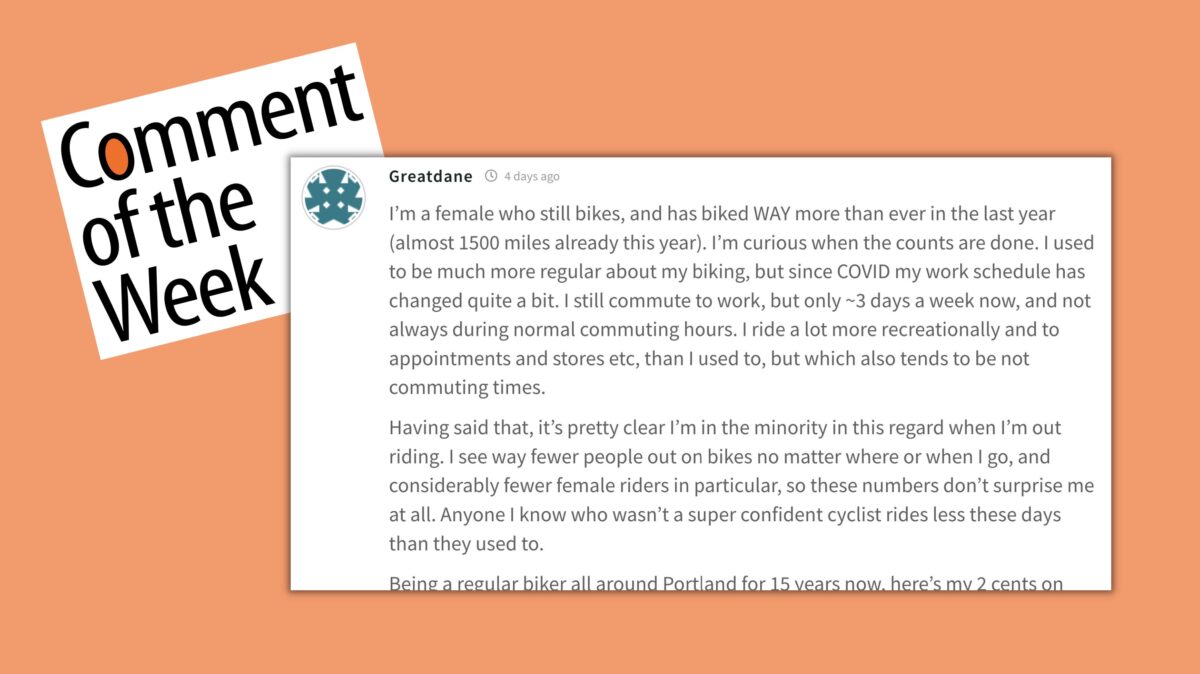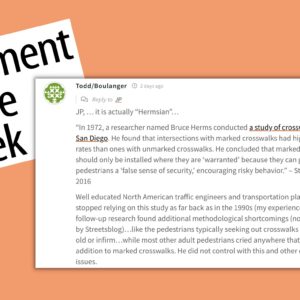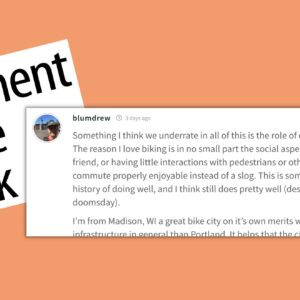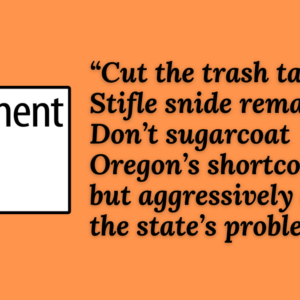Welcome to the Comment of the Week, where we highlight good comments in order to inspire more of them. You can help us choose our next one by replying with “comment of the week” to any comment you think deserves recognition. Please note: These selections are not endorsements.
CityLover summed it up for me, “There’s nothing I love more than browsing the comments section of a meaty BP article, but there are too many even for me tonight!”
Our article, City counts reveal data behind Portland’s precipitous drop in cycling, has received 195 comments — so far. Often when an article gets that many comments there is a, how should I say, falling off of quality. But these comments hold. And they make for poignant reading, some are like little love letters to a past Portland. A bunch of them were really, really good.
One thing I noticed was how many women commented, probably because the PBOT counts showed a big decline in female riders. Women stepped up to explain why.
Greatdane’s comment was a hybrid between the bulleted lists many people put together, and a bit of narrative explaining her situation. I liked the combination of the two. Here’s what she wrote:
I’m a female who still bikes, and has biked WAY more than ever in the last year (almost 1500 miles already this year). I’m curious when the counts are done. I used to be much more regular about my biking, but since COVID my work schedule has changed quite a bit. I still commute to work, but only ~3 days a week now, and not always during normal commuting hours. I ride a lot more recreationally and to appointments and stores etc, than I used to, but which also tends to be not commuting times.
Having said that, it’s pretty clear I’m in the minority in this regard when I’m out riding. I see way fewer people out on bikes no matter where or when I go, and considerably fewer female riders in particular, so these numbers don’t surprise me at all. Anyone I know who wasn’t a super confident cyclist rides less these days than they used to.
Being a regular biker all around Portland for 15 years now, here’s my 2 cents on why biking has declined so much in the past few years…
-Lots of people driving combined with complete lack of traffic enforcement resulting in erratic, unpredictable, and dangerous driving behavior. The number of close calls I’ve had in the past month alone is more than I had for years at a time pre-2019ish.
-Terrible conditions *of the roads* see the cracked crappy pavement of many greenway routes
– Terrible conditions *of the MUPs* see tents and trash on or blocking paths in numerous places. Most of my female friends in particular refuse to ride on these paths at this point, even where there aren’t tents because of perception
-New/improved/existing infrastructure that is nice but often doesn’t make enough connections to other infrastructure resulting in stressful situations many cyclists I know aren’t comfortable in (mostly due to point 1 above at this point)
I agree, it’s going to take a pretty concerted effort to turn things around. The infrastructure (including enforcement) will need improvements to actually support cycling/pedestrian safety. The safest infrastructure in the world won’t make any difference though if perceptions developed over the past few years are aren’t also changed.
Thank you Greatdane! You can find Greatdane’s comment, and the torrent of other good comments, under the original post.







Thanks for reading.
BikePortland has served this community with independent community journalism since 2005. We rely on subscriptions from readers like you to survive. Your financial support is vital in keeping this valuable resource alive and well.
Please subscribe today to strengthen and expand our work.
Regarding motor vehicle drivers behaviour (all the cities I cycle and walk in), yes the COVID19 shift has been stark and how it has reduced traffic safety is pretty blunt and in your face. Drivers running fully red signals…even as late as when perpendicular traffic is starting to move after the all stop clearance phase. (It could only be more threatening if these drivers were brandishing guns + their vehicular weapon.)
Running red lights was bad in 2019 (when compared to the pre1990s etc.) and told friends visiting to wait a full 3 second count once the walk cycle / green for bikes was lit but the COVID era stress, poor enforcement and deserted streets have trained drivers (assuming they have licenses, had drivers ed and a full drivers’ practical test; as many were cancelled) and turned it in to a new era of drivers having “full self entitlement” / psychological disease. If we were to dig deep and research it may be as bad now for pedestrians (and cyclists) as the ~1910 to 1930. This was the last documented great killing field for vulnerable roadway users community wide (all ages, all incomes and areas).
The red light runners are nuts. I was driving home from a concert Sunday night, vehicle in front of me stopped for a red light right after we got off the Hawthorne bridge. Then proceeded to start going through it while it was still very red after being stopped for a few seconds. Almost made the guy next to him start going through too because herd mentality. They both stopped when I honked and woke them up. Nothing wrong with the light either, it was on its usual very reasonable cycle.
Hate to think how that could have turned out if there were cross traffic.
We need enforcement.
It would be nice to get a follow up comment from PPB as to if they think cycling has declined in part because of an increase in crime, road deaths, lack of traffic enforcement and a slow response times to anything less than a murder. And if so, what do they plan to do about it? Since those things all fall under their job descriptions I think those are fair questions.
Comment is pretty much spot on! When women bicyclists speak we should all listen!
Regarding the MUPs; The 205 MUP was like a training ground for those “interested, but concerned” bicyclists to get some miles in the saddle before venturing out onto the streets, and a major contributor to past bike counts in east Portland. With the real, or perceived, issues with the MUPs it’s comments like these that cement the reason for the drop in ridership in east Portland.
My work schedule has changed dramatically since 2020 and I ride less for commuting, but just as much as before for local errands and appointments.
Is it time to change the way bike counts are done? Will commuting to the central city ever return to pre-pandemic numbers?
Thanks for these COTW highlights, I missed a lot of the discussion on that article and have enjoyed going back through with a different attention and state of mind.